Business Environment Analysis: Tesco's Structure and Macro Impacts
VerifiedAdded on 2024/06/07
|23
|5530
|443
Report
AI Summary
This report provides a comprehensive analysis of the business environment, focusing on different organizational types, their functions, and the impact of the macro environment. It begins by explaining various organizational structures such as line, matrix, functional, and divisional organizations, highlighting their characteristics and applications. The report then delves into a detailed examination of Tesco, including its background, products, services, size, scope, vision, mission, business objectives, organizational and legal structure, and key stakeholders. Furthermore, it explores the interrelationship of various functions within an organization, using Tesco as a case study to demonstrate how these functions link to the organizational structure. The report also employs PESTLE analysis to identify and discuss the macro environmental factors that impact business operations, emphasizing both positive and negative influences. Finally, it conducts internal and external analyses, including SWOT, to pinpoint strengths and weaknesses and explain their influence on the decision-making process, offering a holistic view of Tesco's strategic positioning within its operating environment. This student contributed document is available on Desklib, a platform providing a wealth of study resources for students.

[Business and business environment]
2018
2018
Paraphrase This Document
Need a fresh take? Get an instant paraphrase of this document with our AI Paraphraser
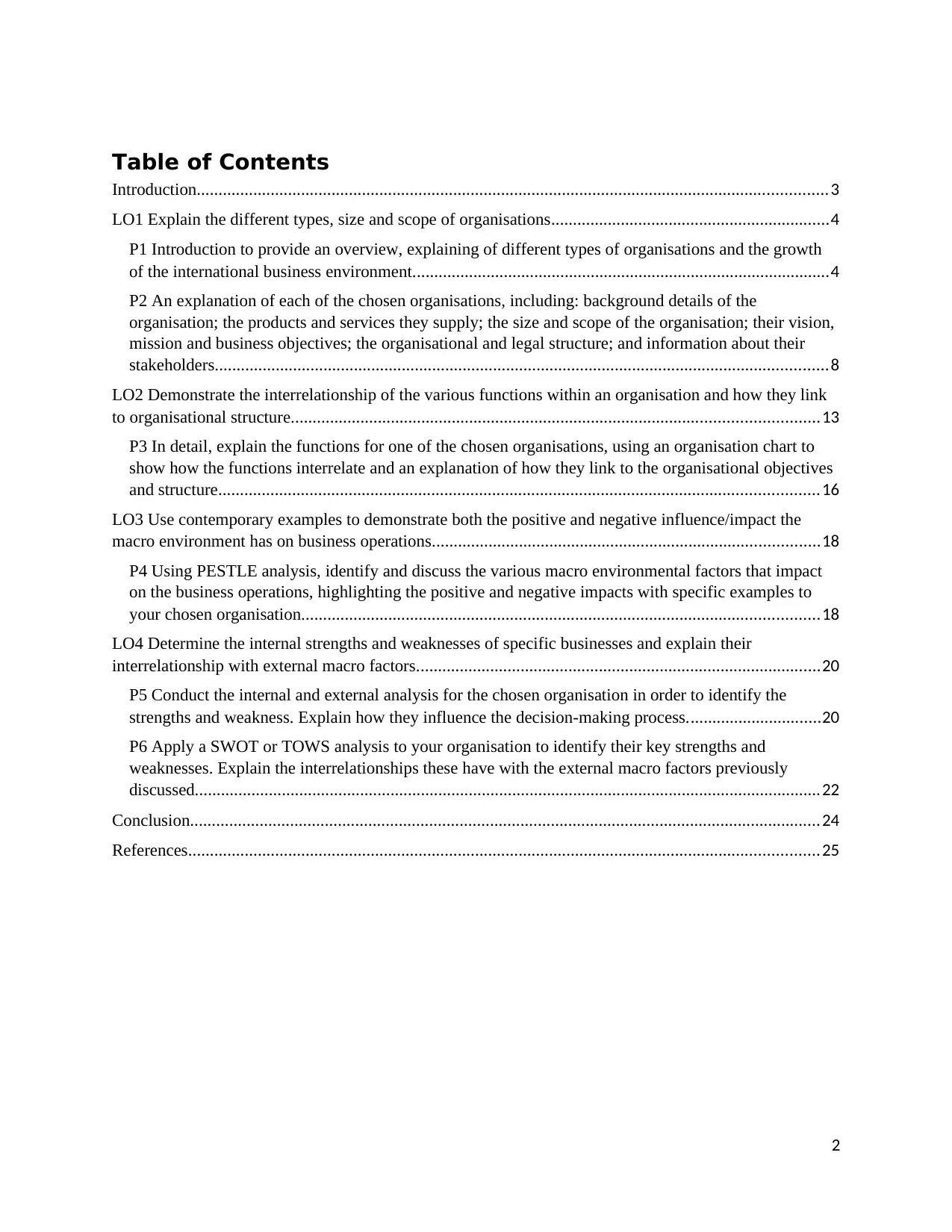
Table of Contents
Introduction.................................................................................................................................................3
LO1 Explain the different types, size and scope of organisations................................................................4
P1 Introduction to provide an overview, explaining of different types of organisations and the growth
of the international business environment................................................................................................4
P2 An explanation of each of the chosen organisations, including: background details of the
organisation; the products and services they supply; the size and scope of the organisation; their vision,
mission and business objectives; the organisational and legal structure; and information about their
stakeholders.............................................................................................................................................8
LO2 Demonstrate the interrelationship of the various functions within an organisation and how they link
to organisational structure.........................................................................................................................13
P3 In detail, explain the functions for one of the chosen organisations, using an organisation chart to
show how the functions interrelate and an explanation of how they link to the organisational objectives
and structure..........................................................................................................................................16
LO3 Use contemporary examples to demonstrate both the positive and negative influence/impact the
macro environment has on business operations.........................................................................................18
P4 Using PESTLE analysis, identify and discuss the various macro environmental factors that impact
on the business operations, highlighting the positive and negative impacts with specific examples to
your chosen organisation.......................................................................................................................18
LO4 Determine the internal strengths and weaknesses of specific businesses and explain their
interrelationship with external macro factors.............................................................................................20
P5 Conduct the internal and external analysis for the chosen organisation in order to identify the
strengths and weakness. Explain how they influence the decision-making process...............................20
P6 Apply a SWOT or TOWS analysis to your organisation to identify their key strengths and
weaknesses. Explain the interrelationships these have with the external macro factors previously
discussed................................................................................................................................................22
Conclusion.................................................................................................................................................24
References.................................................................................................................................................25
2
Introduction.................................................................................................................................................3
LO1 Explain the different types, size and scope of organisations................................................................4
P1 Introduction to provide an overview, explaining of different types of organisations and the growth
of the international business environment................................................................................................4
P2 An explanation of each of the chosen organisations, including: background details of the
organisation; the products and services they supply; the size and scope of the organisation; their vision,
mission and business objectives; the organisational and legal structure; and information about their
stakeholders.............................................................................................................................................8
LO2 Demonstrate the interrelationship of the various functions within an organisation and how they link
to organisational structure.........................................................................................................................13
P3 In detail, explain the functions for one of the chosen organisations, using an organisation chart to
show how the functions interrelate and an explanation of how they link to the organisational objectives
and structure..........................................................................................................................................16
LO3 Use contemporary examples to demonstrate both the positive and negative influence/impact the
macro environment has on business operations.........................................................................................18
P4 Using PESTLE analysis, identify and discuss the various macro environmental factors that impact
on the business operations, highlighting the positive and negative impacts with specific examples to
your chosen organisation.......................................................................................................................18
LO4 Determine the internal strengths and weaknesses of specific businesses and explain their
interrelationship with external macro factors.............................................................................................20
P5 Conduct the internal and external analysis for the chosen organisation in order to identify the
strengths and weakness. Explain how they influence the decision-making process...............................20
P6 Apply a SWOT or TOWS analysis to your organisation to identify their key strengths and
weaknesses. Explain the interrelationships these have with the external macro factors previously
discussed................................................................................................................................................22
Conclusion.................................................................................................................................................24
References.................................................................................................................................................25
2
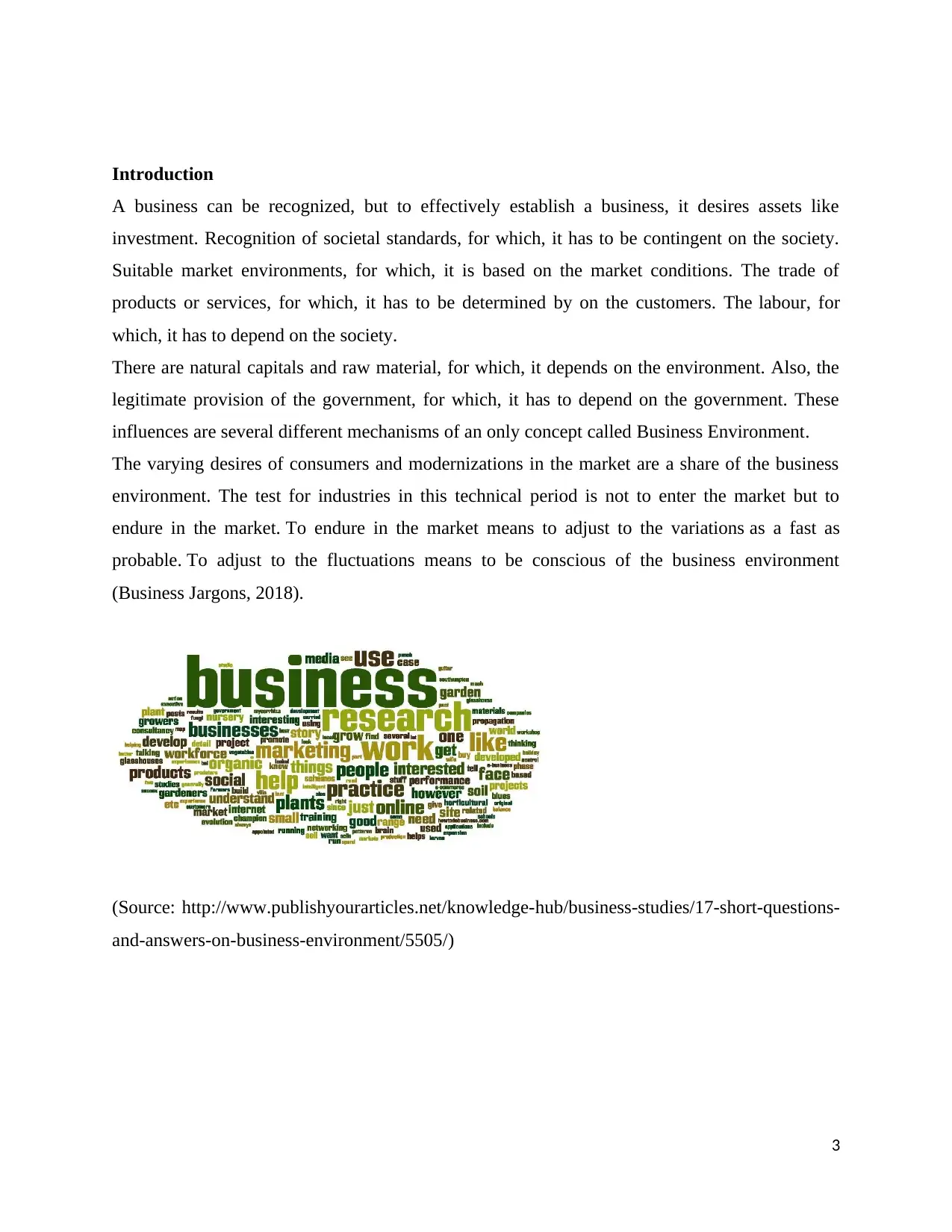
Introduction
A business can be recognized, but to effectively establish a business, it desires assets like
investment. Recognition of societal standards, for which, it has to be contingent on the society.
Suitable market environments, for which, it is based on the market conditions. The trade of
products or services, for which, it has to be determined by on the customers. The labour, for
which, it has to depend on the society.
There are natural capitals and raw material, for which, it depends on the environment. Also, the
legitimate provision of the government, for which, it has to depend on the government. These
influences are several different mechanisms of an only concept called Business Environment.
The varying desires of consumers and modernizations in the market are a share of the business
environment. The test for industries in this technical period is not to enter the market but to
endure in the market. To endure in the market means to adjust to the variations as a fast as
probable. To adjust to the fluctuations means to be conscious of the business environment
(Business Jargons, 2018).
(Source: http://www.publishyourarticles.net/knowledge-hub/business-studies/17-short-questions-
and-answers-on-business-environment/5505/)
3
A business can be recognized, but to effectively establish a business, it desires assets like
investment. Recognition of societal standards, for which, it has to be contingent on the society.
Suitable market environments, for which, it is based on the market conditions. The trade of
products or services, for which, it has to be determined by on the customers. The labour, for
which, it has to depend on the society.
There are natural capitals and raw material, for which, it depends on the environment. Also, the
legitimate provision of the government, for which, it has to depend on the government. These
influences are several different mechanisms of an only concept called Business Environment.
The varying desires of consumers and modernizations in the market are a share of the business
environment. The test for industries in this technical period is not to enter the market but to
endure in the market. To endure in the market means to adjust to the variations as a fast as
probable. To adjust to the fluctuations means to be conscious of the business environment
(Business Jargons, 2018).
(Source: http://www.publishyourarticles.net/knowledge-hub/business-studies/17-short-questions-
and-answers-on-business-environment/5505/)
3
⊘ This is a preview!⊘
Do you want full access?
Subscribe today to unlock all pages.

Trusted by 1+ million students worldwide

LO1 Explain the different types, size and scope of organisations
P1 Introduction to provide an overview, explaining of different types of organisations and
the growth of the international business environment.
Types of organisation:
a. Line organisation:
(Source: https://managementmania.com/en/staff-line-organisational-structure)
Line organisation is the oldest type of organisation structure. Under this organisation
information flows straight and vertically from the upper of the executive hierarchy i.e.
from top management to the lower management level down in the company structure.
Line organisation classifies power, accountability at each level. The employees in line
organisation are involved in aiming organisation need (Farooq, 2012).
1. Matrix organisation:
(Source: https://managementmania.com/en/matrix-organisational-structure)
4
P1 Introduction to provide an overview, explaining of different types of organisations and
the growth of the international business environment.
Types of organisation:
a. Line organisation:
(Source: https://managementmania.com/en/staff-line-organisational-structure)
Line organisation is the oldest type of organisation structure. Under this organisation
information flows straight and vertically from the upper of the executive hierarchy i.e.
from top management to the lower management level down in the company structure.
Line organisation classifies power, accountability at each level. The employees in line
organisation are involved in aiming organisation need (Farooq, 2012).
1. Matrix organisation:
(Source: https://managementmania.com/en/matrix-organisational-structure)
4
Paraphrase This Document
Need a fresh take? Get an instant paraphrase of this document with our AI Paraphraser
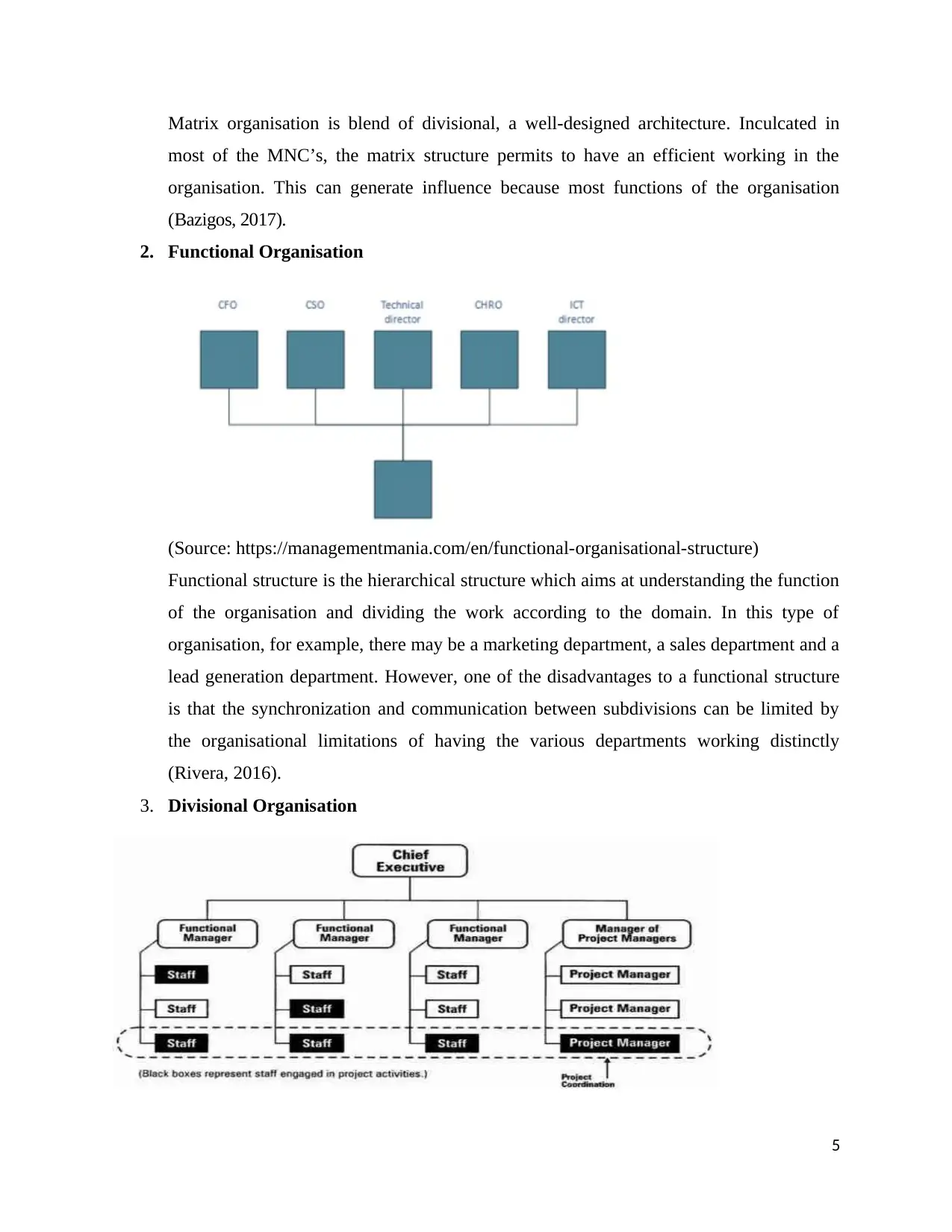
Matrix organisation is blend of divisional, a well-designed architecture. Inculcated in
most of the MNC’s, the matrix structure permits to have an efficient working in the
organisation. This can generate influence because most functions of the organisation
(Bazigos, 2017).
2. Functional Organisation
(Source: https://managementmania.com/en/functional-organisational-structure)
Functional structure is the hierarchical structure which aims at understanding the function
of the organisation and dividing the work according to the domain. In this type of
organisation, for example, there may be a marketing department, a sales department and a
lead generation department. However, one of the disadvantages to a functional structure
is that the synchronization and communication between subdivisions can be limited by
the organisational limitations of having the various departments working distinctly
(Rivera, 2016).
3. Divisional Organisation
5
most of the MNC’s, the matrix structure permits to have an efficient working in the
organisation. This can generate influence because most functions of the organisation
(Bazigos, 2017).
2. Functional Organisation
(Source: https://managementmania.com/en/functional-organisational-structure)
Functional structure is the hierarchical structure which aims at understanding the function
of the organisation and dividing the work according to the domain. In this type of
organisation, for example, there may be a marketing department, a sales department and a
lead generation department. However, one of the disadvantages to a functional structure
is that the synchronization and communication between subdivisions can be limited by
the organisational limitations of having the various departments working distinctly
(Rivera, 2016).
3. Divisional Organisation
5

(Source: https://www.managementstudyhq.com/types-of-organizational-structures.html)
This kind of structure usually exists in MNC’s that function extensively in most of the
regions/area or that have an isolated minor corporates to have innovation in a product and
invent according the customer need.
The advantage of this structure is that requirements can be seen more promptly and more
precisely. Divisional structure is expensive because of its scope. Small organisations can
opt divisional structure on a smaller scale, having different workplaces in different parts
of the city, for example, or allocating different sales teams to handle different geographic
areas (Alton, 2017).
Growth of the international business environment
(Source: https://www.dreamstime.com/businessman-holding-globe-hand-international-business-
environment-reservation-concept-elements-image-furnished-b-image103757471)
International Business Environment includes the governmental risks, social variances, lawful &
other issues. IBE includes the political, economic, social & traditional, legal, & high-tech
environment, IBE helps in the following area:
Sales growth
Sales through exports in one of the ways of organisational growth. The vendors who provide raw
materials also experience growth in their sales volume.
Generates Employments
6
This kind of structure usually exists in MNC’s that function extensively in most of the
regions/area or that have an isolated minor corporates to have innovation in a product and
invent according the customer need.
The advantage of this structure is that requirements can be seen more promptly and more
precisely. Divisional structure is expensive because of its scope. Small organisations can
opt divisional structure on a smaller scale, having different workplaces in different parts
of the city, for example, or allocating different sales teams to handle different geographic
areas (Alton, 2017).
Growth of the international business environment
(Source: https://www.dreamstime.com/businessman-holding-globe-hand-international-business-
environment-reservation-concept-elements-image-furnished-b-image103757471)
International Business Environment includes the governmental risks, social variances, lawful &
other issues. IBE includes the political, economic, social & traditional, legal, & high-tech
environment, IBE helps in the following area:
Sales growth
Sales through exports in one of the ways of organisational growth. The vendors who provide raw
materials also experience growth in their sales volume.
Generates Employments
6
⊘ This is a preview!⊘
Do you want full access?
Subscribe today to unlock all pages.

Trusted by 1+ million students worldwide
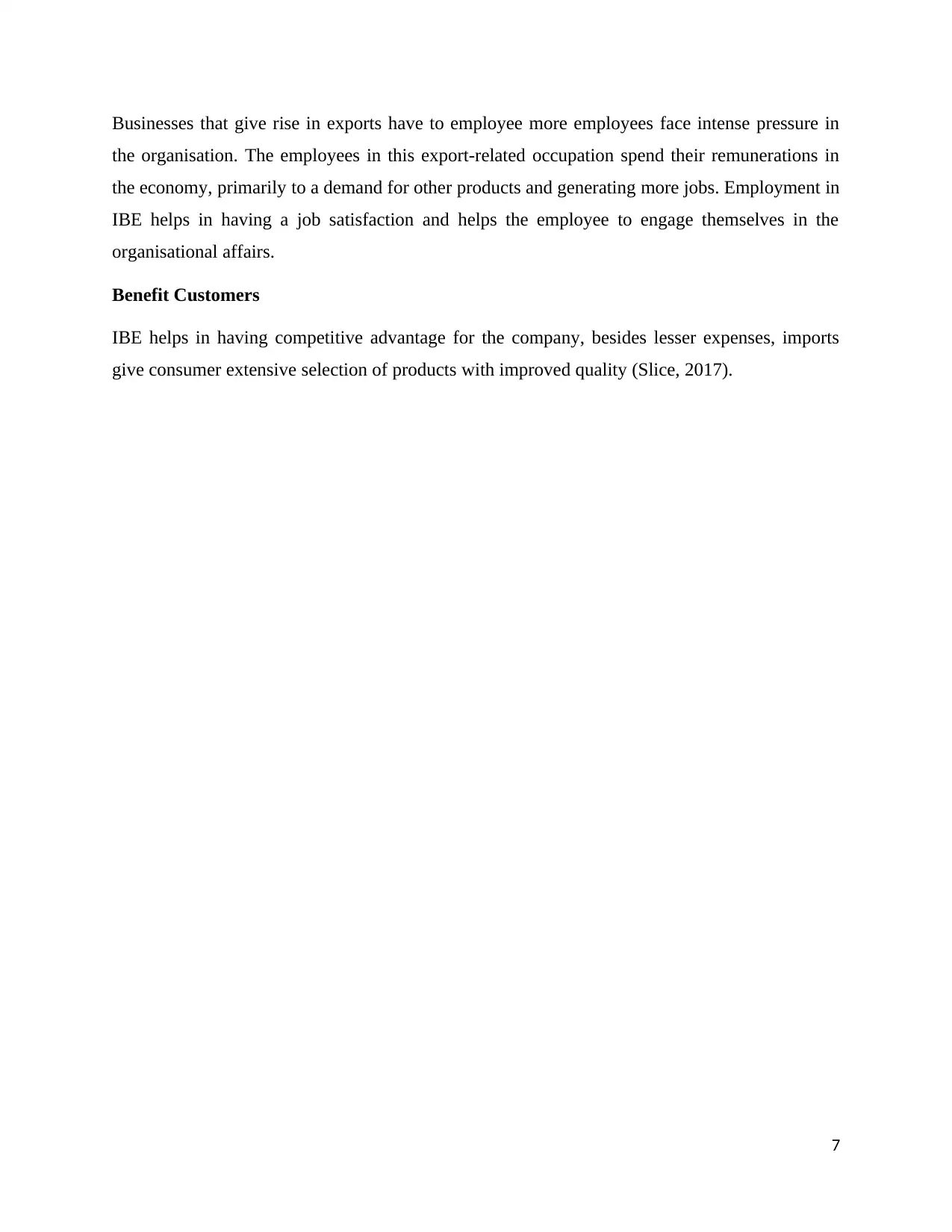
Businesses that give rise in exports have to employee more employees face intense pressure in
the organisation. The employees in this export-related occupation spend their remunerations in
the economy, primarily to a demand for other products and generating more jobs. Employment in
IBE helps in having a job satisfaction and helps the employee to engage themselves in the
organisational affairs.
Benefit Customers
IBE helps in having competitive advantage for the company, besides lesser expenses, imports
give consumer extensive selection of products with improved quality (Slice, 2017).
7
the organisation. The employees in this export-related occupation spend their remunerations in
the economy, primarily to a demand for other products and generating more jobs. Employment in
IBE helps in having a job satisfaction and helps the employee to engage themselves in the
organisational affairs.
Benefit Customers
IBE helps in having competitive advantage for the company, besides lesser expenses, imports
give consumer extensive selection of products with improved quality (Slice, 2017).
7
Paraphrase This Document
Need a fresh take? Get an instant paraphrase of this document with our AI Paraphraser
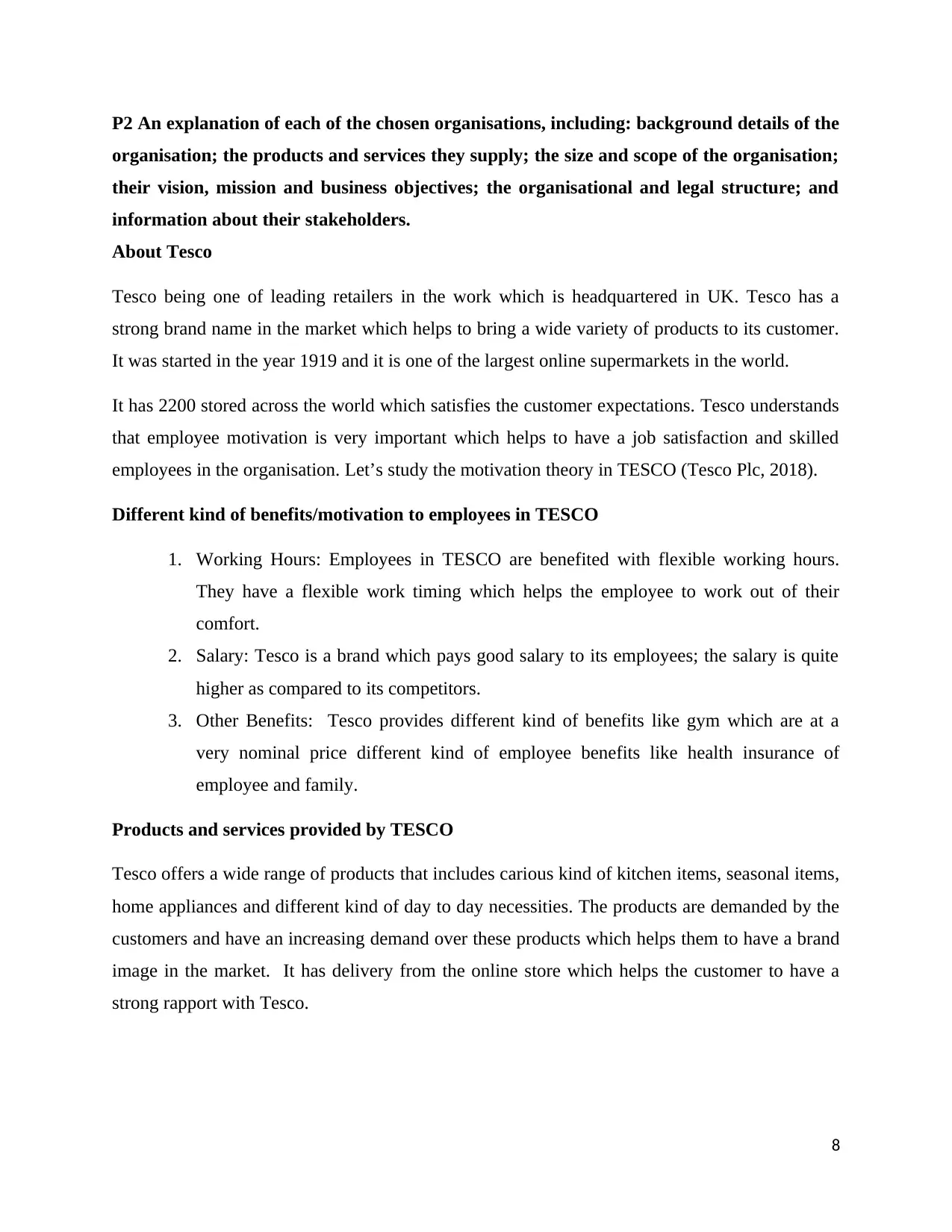
P2 An explanation of each of the chosen organisations, including: background details of the
organisation; the products and services they supply; the size and scope of the organisation;
their vision, mission and business objectives; the organisational and legal structure; and
information about their stakeholders.
About Tesco
Tesco being one of leading retailers in the work which is headquartered in UK. Tesco has a
strong brand name in the market which helps to bring a wide variety of products to its customer.
It was started in the year 1919 and it is one of the largest online supermarkets in the world.
It has 2200 stored across the world which satisfies the customer expectations. Tesco understands
that employee motivation is very important which helps to have a job satisfaction and skilled
employees in the organisation. Let’s study the motivation theory in TESCO (Tesco Plc, 2018).
Different kind of benefits/motivation to employees in TESCO
1. Working Hours: Employees in TESCO are benefited with flexible working hours.
They have a flexible work timing which helps the employee to work out of their
comfort.
2. Salary: Tesco is a brand which pays good salary to its employees; the salary is quite
higher as compared to its competitors.
3. Other Benefits: Tesco provides different kind of benefits like gym which are at a
very nominal price different kind of employee benefits like health insurance of
employee and family.
Products and services provided by TESCO
Tesco offers a wide range of products that includes carious kind of kitchen items, seasonal items,
home appliances and different kind of day to day necessities. The products are demanded by the
customers and have an increasing demand over these products which helps them to have a brand
image in the market. It has delivery from the online store which helps the customer to have a
strong rapport with Tesco.
8
organisation; the products and services they supply; the size and scope of the organisation;
their vision, mission and business objectives; the organisational and legal structure; and
information about their stakeholders.
About Tesco
Tesco being one of leading retailers in the work which is headquartered in UK. Tesco has a
strong brand name in the market which helps to bring a wide variety of products to its customer.
It was started in the year 1919 and it is one of the largest online supermarkets in the world.
It has 2200 stored across the world which satisfies the customer expectations. Tesco understands
that employee motivation is very important which helps to have a job satisfaction and skilled
employees in the organisation. Let’s study the motivation theory in TESCO (Tesco Plc, 2018).
Different kind of benefits/motivation to employees in TESCO
1. Working Hours: Employees in TESCO are benefited with flexible working hours.
They have a flexible work timing which helps the employee to work out of their
comfort.
2. Salary: Tesco is a brand which pays good salary to its employees; the salary is quite
higher as compared to its competitors.
3. Other Benefits: Tesco provides different kind of benefits like gym which are at a
very nominal price different kind of employee benefits like health insurance of
employee and family.
Products and services provided by TESCO
Tesco offers a wide range of products that includes carious kind of kitchen items, seasonal items,
home appliances and different kind of day to day necessities. The products are demanded by the
customers and have an increasing demand over these products which helps them to have a brand
image in the market. It has delivery from the online store which helps the customer to have a
strong rapport with Tesco.
8
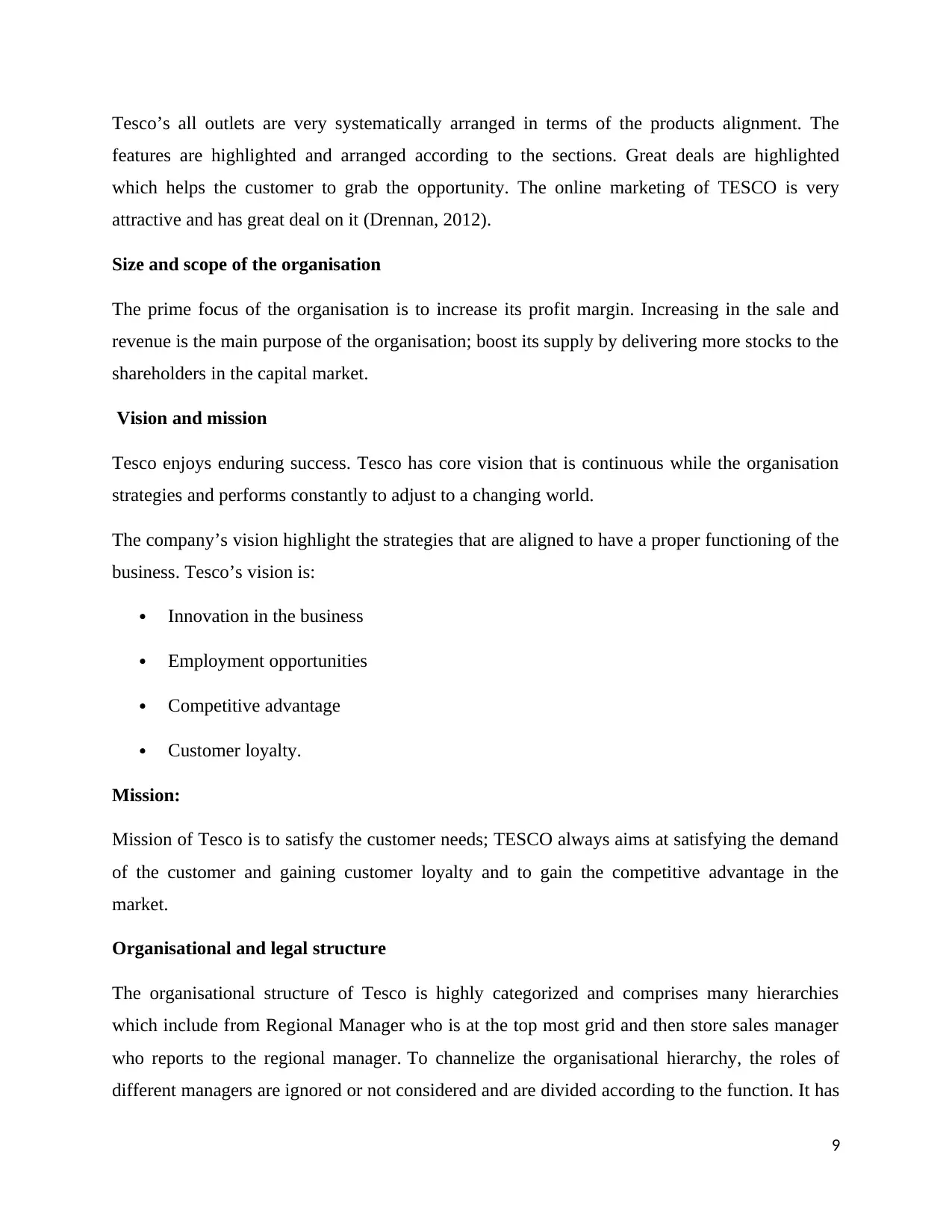
Tesco’s all outlets are very systematically arranged in terms of the products alignment. The
features are highlighted and arranged according to the sections. Great deals are highlighted
which helps the customer to grab the opportunity. The online marketing of TESCO is very
attractive and has great deal on it (Drennan, 2012).
Size and scope of the organisation
The prime focus of the organisation is to increase its profit margin. Increasing in the sale and
revenue is the main purpose of the organisation; boost its supply by delivering more stocks to the
shareholders in the capital market.
Vision and mission
Tesco enjoys enduring success. Tesco has core vision that is continuous while the organisation
strategies and performs constantly to adjust to a changing world.
The company’s vision highlight the strategies that are aligned to have a proper functioning of the
business. Tesco’s vision is:
Innovation in the business
Employment opportunities
Competitive advantage
Customer loyalty.
Mission:
Mission of Tesco is to satisfy the customer needs; TESCO always aims at satisfying the demand
of the customer and gaining customer loyalty and to gain the competitive advantage in the
market.
Organisational and legal structure
The organisational structure of Tesco is highly categorized and comprises many hierarchies
which include from Regional Manager who is at the top most grid and then store sales manager
who reports to the regional manager. To channelize the organisational hierarchy, the roles of
different managers are ignored or not considered and are divided according to the function. It has
9
features are highlighted and arranged according to the sections. Great deals are highlighted
which helps the customer to grab the opportunity. The online marketing of TESCO is very
attractive and has great deal on it (Drennan, 2012).
Size and scope of the organisation
The prime focus of the organisation is to increase its profit margin. Increasing in the sale and
revenue is the main purpose of the organisation; boost its supply by delivering more stocks to the
shareholders in the capital market.
Vision and mission
Tesco enjoys enduring success. Tesco has core vision that is continuous while the organisation
strategies and performs constantly to adjust to a changing world.
The company’s vision highlight the strategies that are aligned to have a proper functioning of the
business. Tesco’s vision is:
Innovation in the business
Employment opportunities
Competitive advantage
Customer loyalty.
Mission:
Mission of Tesco is to satisfy the customer needs; TESCO always aims at satisfying the demand
of the customer and gaining customer loyalty and to gain the competitive advantage in the
market.
Organisational and legal structure
The organisational structure of Tesco is highly categorized and comprises many hierarchies
which include from Regional Manager who is at the top most grid and then store sales manager
who reports to the regional manager. To channelize the organisational hierarchy, the roles of
different managers are ignored or not considered and are divided according to the function. It has
9
⊘ This is a preview!⊘
Do you want full access?
Subscribe today to unlock all pages.

Trusted by 1+ million students worldwide
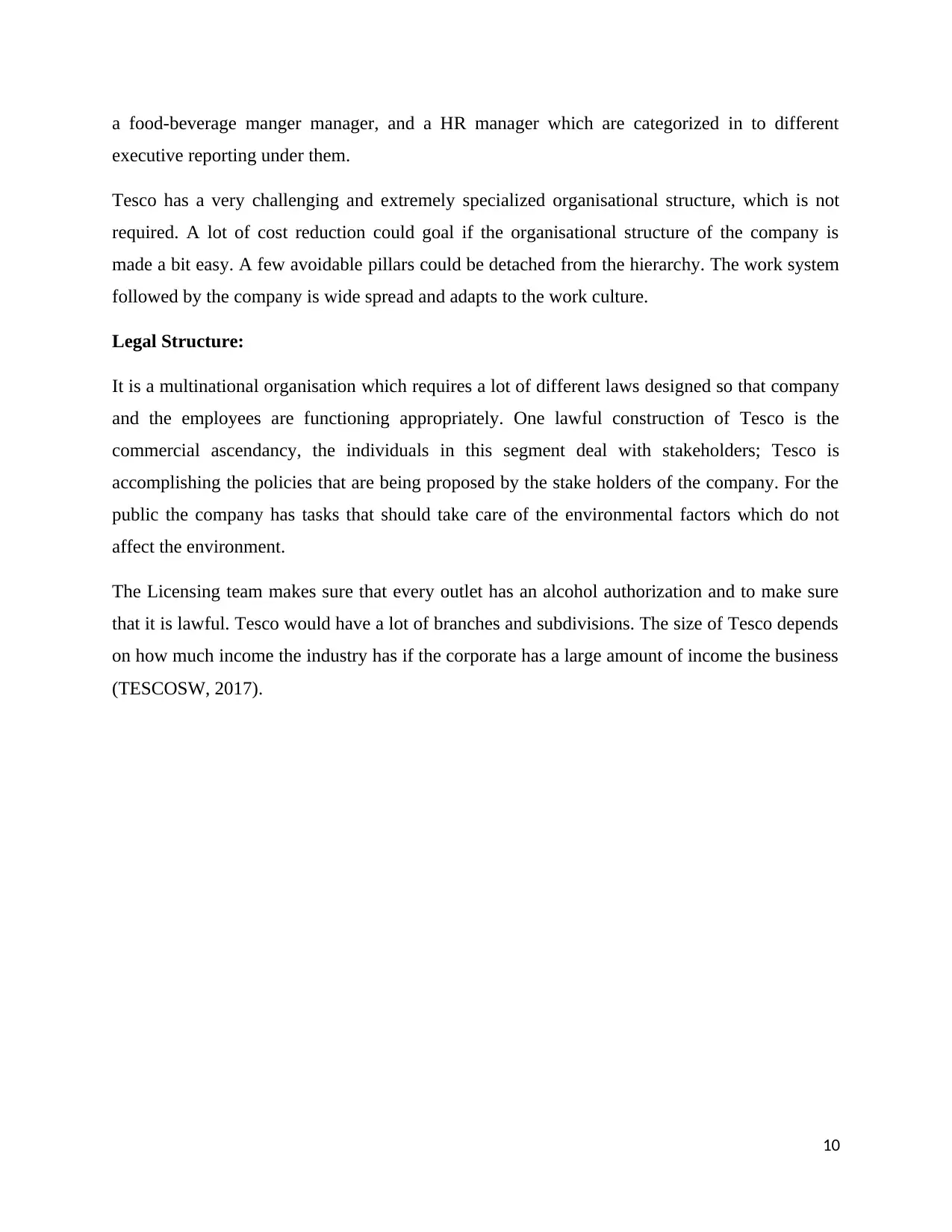
a food-beverage manger manager, and a HR manager which are categorized in to different
executive reporting under them.
Tesco has a very challenging and extremely specialized organisational structure, which is not
required. A lot of cost reduction could goal if the organisational structure of the company is
made a bit easy. A few avoidable pillars could be detached from the hierarchy. The work system
followed by the company is wide spread and adapts to the work culture.
Legal Structure:
It is a multinational organisation which requires a lot of different laws designed so that company
and the employees are functioning appropriately. One lawful construction of Tesco is the
commercial ascendancy, the individuals in this segment deal with stakeholders; Tesco is
accomplishing the policies that are being proposed by the stake holders of the company. For the
public the company has tasks that should take care of the environmental factors which do not
affect the environment.
The Licensing team makes sure that every outlet has an alcohol authorization and to make sure
that it is lawful. Tesco would have a lot of branches and subdivisions. The size of Tesco depends
on how much income the industry has if the corporate has a large amount of income the business
(TESCOSW, 2017).
10
executive reporting under them.
Tesco has a very challenging and extremely specialized organisational structure, which is not
required. A lot of cost reduction could goal if the organisational structure of the company is
made a bit easy. A few avoidable pillars could be detached from the hierarchy. The work system
followed by the company is wide spread and adapts to the work culture.
Legal Structure:
It is a multinational organisation which requires a lot of different laws designed so that company
and the employees are functioning appropriately. One lawful construction of Tesco is the
commercial ascendancy, the individuals in this segment deal with stakeholders; Tesco is
accomplishing the policies that are being proposed by the stake holders of the company. For the
public the company has tasks that should take care of the environmental factors which do not
affect the environment.
The Licensing team makes sure that every outlet has an alcohol authorization and to make sure
that it is lawful. Tesco would have a lot of branches and subdivisions. The size of Tesco depends
on how much income the industry has if the corporate has a large amount of income the business
(TESCOSW, 2017).
10
Paraphrase This Document
Need a fresh take? Get an instant paraphrase of this document with our AI Paraphraser

LO2 Demonstrate the interrelationship of the various functions within an organisation and
how they link to organisational structure.
Every company has list of functions which help the organisation to grow, learn and earn, the
organisations are sib divided in various functions which help the company to carry out the roles
and responsibilities in an appropriate manner, hence which helps the company to grow:
Research and Development (R&D)
Personnel Management
Financial and accounting Management
Sales and Marketing
In an organisation it is very vital to carry out the functions in an appropriate manner which help
the company to run smoothly, thus as a result different functions of the organisation helps in
having a string decision making process, which helps the organisation to run successfully and
helps the employees to co-ordinate with each other. As a result, there will be a smooth
communication in the organisation and transparency to carry out all the task effectively, below
are the few functions of the organisation which helps to understand the few areas:
Research and Development: the motive of every organisation is to scrutinize the
requirement and necessity of the consumers on that basis they will be able to able to
design and develop a product according to the market and customer specification. The
Research and Development (R&D) function is apprehensive with emerging new products
or methods and refining current products and services. This helps to understand the
customer requirement and helps to innovate a product according to the needs and wants
of the customer and helps in understanding the customers demand which helps in
designing a product which gives best result.
Financial Management: Financial management is one of the key function of an
organisation to perform, FM helps in understanding the current trends and the key assets
of the organisation. Financial management helps in revising the company’s budget
simultaneously understanding the customers need and demand for the product.
Understanding the tax and what will be profit from the product which the company will
be able to analyse by financial planning.
Sales and Marketing: Sales and marketing are the key functions of any organisation,
sales helps o understand the sale and the revenue of the product. As a result, this helps in
11
how they link to organisational structure.
Every company has list of functions which help the organisation to grow, learn and earn, the
organisations are sib divided in various functions which help the company to carry out the roles
and responsibilities in an appropriate manner, hence which helps the company to grow:
Research and Development (R&D)
Personnel Management
Financial and accounting Management
Sales and Marketing
In an organisation it is very vital to carry out the functions in an appropriate manner which help
the company to run smoothly, thus as a result different functions of the organisation helps in
having a string decision making process, which helps the organisation to run successfully and
helps the employees to co-ordinate with each other. As a result, there will be a smooth
communication in the organisation and transparency to carry out all the task effectively, below
are the few functions of the organisation which helps to understand the few areas:
Research and Development: the motive of every organisation is to scrutinize the
requirement and necessity of the consumers on that basis they will be able to able to
design and develop a product according to the market and customer specification. The
Research and Development (R&D) function is apprehensive with emerging new products
or methods and refining current products and services. This helps to understand the
customer requirement and helps to innovate a product according to the needs and wants
of the customer and helps in understanding the customers demand which helps in
designing a product which gives best result.
Financial Management: Financial management is one of the key function of an
organisation to perform, FM helps in understanding the current trends and the key assets
of the organisation. Financial management helps in revising the company’s budget
simultaneously understanding the customers need and demand for the product.
Understanding the tax and what will be profit from the product which the company will
be able to analyse by financial planning.
Sales and Marketing: Sales and marketing are the key functions of any organisation,
sales helps o understand the sale and the revenue of the product. As a result, this helps in
11
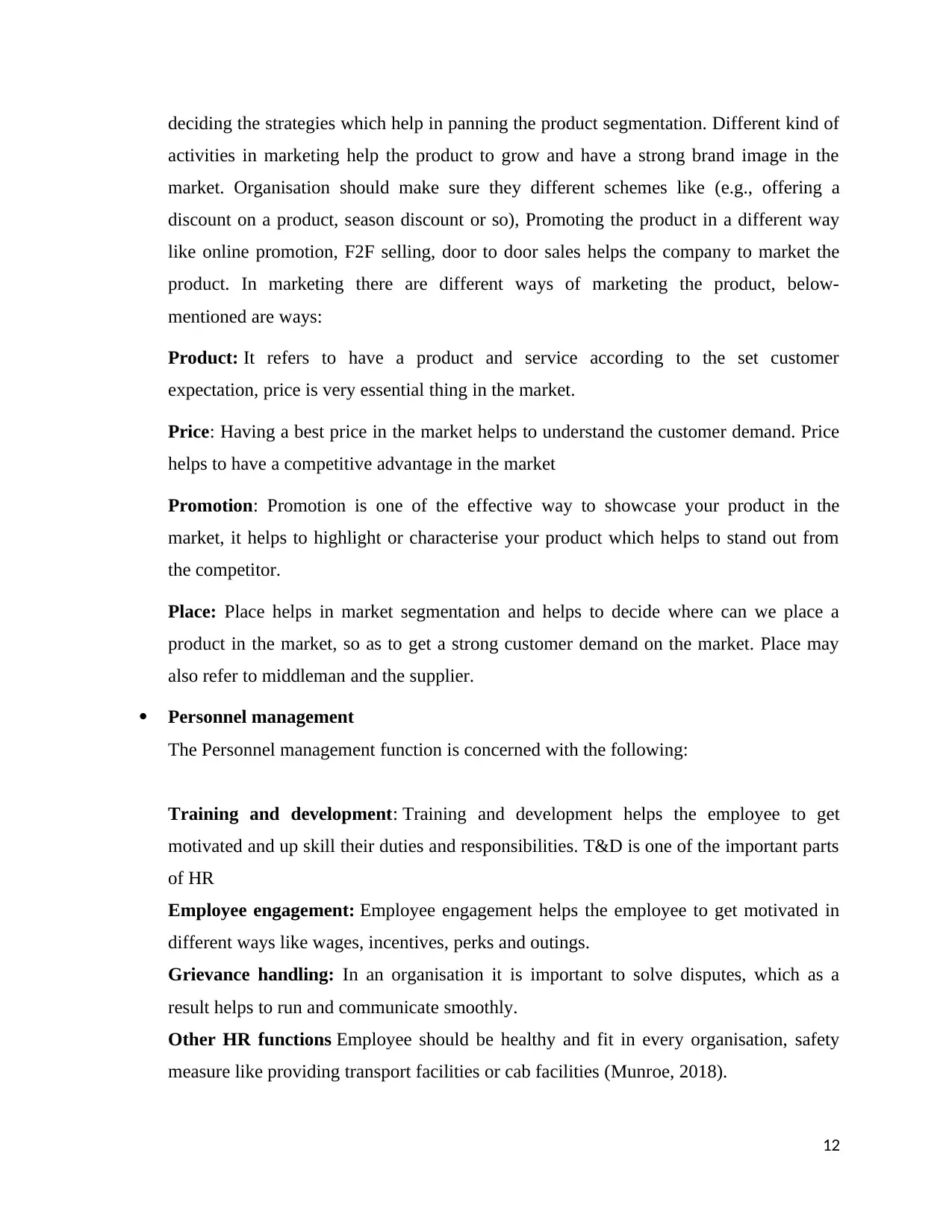
deciding the strategies which help in panning the product segmentation. Different kind of
activities in marketing help the product to grow and have a strong brand image in the
market. Organisation should make sure they different schemes like (e.g., offering a
discount on a product, season discount or so), Promoting the product in a different way
like online promotion, F2F selling, door to door sales helps the company to market the
product. In marketing there are different ways of marketing the product, below-
mentioned are ways:
Product: It refers to have a product and service according to the set customer
expectation, price is very essential thing in the market.
Price: Having a best price in the market helps to understand the customer demand. Price
helps to have a competitive advantage in the market
Promotion: Promotion is one of the effective way to showcase your product in the
market, it helps to highlight or characterise your product which helps to stand out from
the competitor.
Place: Place helps in market segmentation and helps to decide where can we place a
product in the market, so as to get a strong customer demand on the market. Place may
also refer to middleman and the supplier.
Personnel management
The Personnel management function is concerned with the following:
Training and development: Training and development helps the employee to get
motivated and up skill their duties and responsibilities. T&D is one of the important parts
of HR
Employee engagement: Employee engagement helps the employee to get motivated in
different ways like wages, incentives, perks and outings.
Grievance handling: In an organisation it is important to solve disputes, which as a
result helps to run and communicate smoothly.
Other HR functions Employee should be healthy and fit in every organisation, safety
measure like providing transport facilities or cab facilities (Munroe, 2018).
12
activities in marketing help the product to grow and have a strong brand image in the
market. Organisation should make sure they different schemes like (e.g., offering a
discount on a product, season discount or so), Promoting the product in a different way
like online promotion, F2F selling, door to door sales helps the company to market the
product. In marketing there are different ways of marketing the product, below-
mentioned are ways:
Product: It refers to have a product and service according to the set customer
expectation, price is very essential thing in the market.
Price: Having a best price in the market helps to understand the customer demand. Price
helps to have a competitive advantage in the market
Promotion: Promotion is one of the effective way to showcase your product in the
market, it helps to highlight or characterise your product which helps to stand out from
the competitor.
Place: Place helps in market segmentation and helps to decide where can we place a
product in the market, so as to get a strong customer demand on the market. Place may
also refer to middleman and the supplier.
Personnel management
The Personnel management function is concerned with the following:
Training and development: Training and development helps the employee to get
motivated and up skill their duties and responsibilities. T&D is one of the important parts
of HR
Employee engagement: Employee engagement helps the employee to get motivated in
different ways like wages, incentives, perks and outings.
Grievance handling: In an organisation it is important to solve disputes, which as a
result helps to run and communicate smoothly.
Other HR functions Employee should be healthy and fit in every organisation, safety
measure like providing transport facilities or cab facilities (Munroe, 2018).
12
⊘ This is a preview!⊘
Do you want full access?
Subscribe today to unlock all pages.

Trusted by 1+ million students worldwide
1 out of 23
Related Documents
Your All-in-One AI-Powered Toolkit for Academic Success.
+13062052269
info@desklib.com
Available 24*7 on WhatsApp / Email
![[object Object]](/_next/static/media/star-bottom.7253800d.svg)
Unlock your academic potential
Copyright © 2020–2025 A2Z Services. All Rights Reserved. Developed and managed by ZUCOL.

